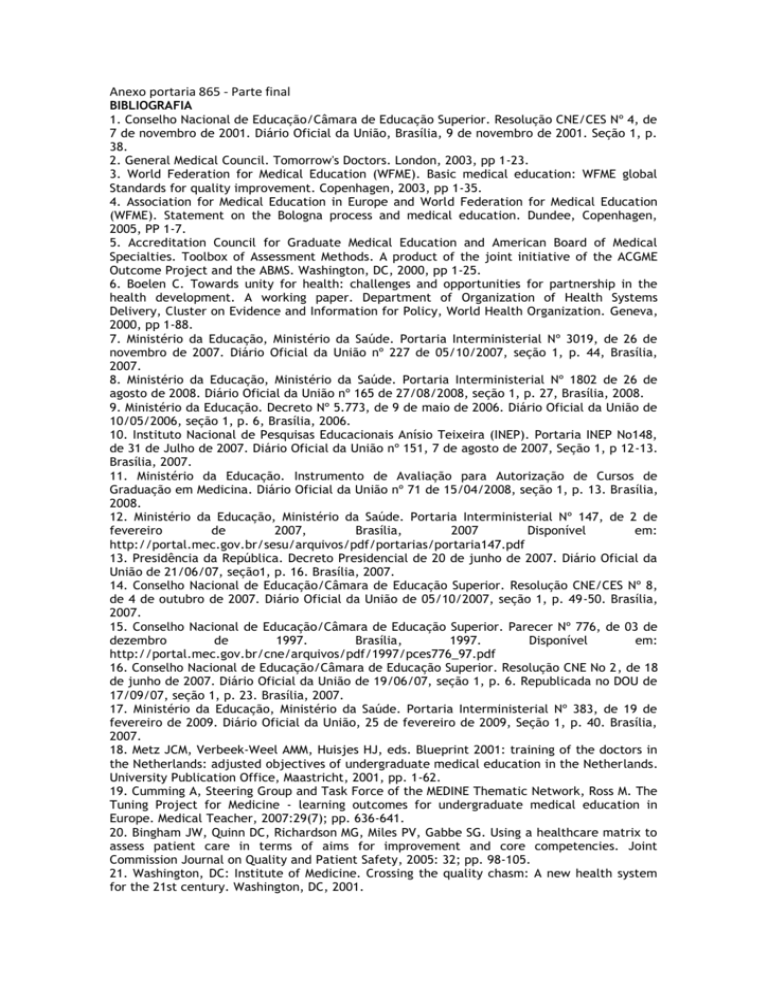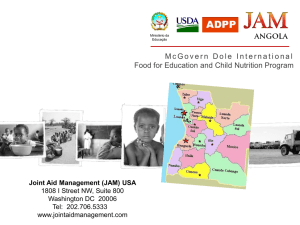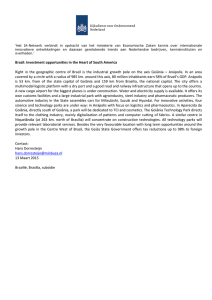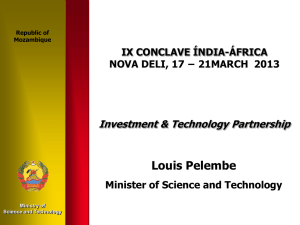Anexo portaria 865 - Parte final BIBLIOGRAFIA 1. Conselho
advertisement

Anexo portaria 865 - Parte final BIBLIOGRAFIA 1. Conselho Nacional de Educação/Câmara de Educação Superior. Resolução CNE/CES Nº 4, de 7 de novembro de 2001. Diário Oficial da União, Brasília, 9 de novembro de 2001. Seção 1, p. 38. 2. General Medical Council. Tomorrow's Doctors. London, 2003, pp 1-23. 3. World Federation for Medical Education (WFME). Basic medical education: WFME global Standards for quality improvement. Copenhagen, 2003, pp 1-35. 4. Association for Medical Education in Europe and World Federation for Medical Education (WFME). Statement on the Bologna process and medical education. Dundee, Copenhagen, 2005, PP 1-7. 5. Accreditation Council for Graduate Medical Education and American Board of Medical Specialties. Toolbox of Assessment Methods. A product of the joint initiative of the ACGME Outcome Project and the ABMS. Washington, DC, 2000, pp 1-25. 6. Boelen C. Towards unity for health: challenges and opportunities for partnership in the health development. A working paper. Department of Organization of Health Systems Delivery, Cluster on Evidence and Information for Policy, World Health Organization. Geneva, 2000, pp 1-88. 7. Ministério da Educação, Ministério da Saúde. Portaria Interministerial Nº 3019, de 26 de novembro de 2007. Diário Oficial da União nº 227 de 05/10/2007, seção 1, p. 44, Brasília, 2007. 8. Ministério da Educação, Ministério da Saúde. Portaria Interministerial Nº 1802 de 26 de agosto de 2008. Diário Oficial da União nº 165 de 27/08/2008, seção 1, p. 27, Brasília, 2008. 9. Ministério da Educação. Decreto Nº 5.773, de 9 de maio de 2006. Diário Oficial da União de 10/05/2006, seção 1, p. 6, Brasília, 2006. 10. Instituto Nacional de Pesquisas Educacionais Anísio Teixeira (INEP). Portaria INEP No148, de 31 de Julho de 2007. Diário Oficial da União nº 151, 7 de agosto de 2007, Seção 1, p 12-13. Brasília, 2007. 11. Ministério da Educação. Instrumento de Avaliação para Autorização de Cursos de Graduação em Medicina. Diário Oficial da União nº 71 de 15/04/2008, seção 1, p. 13. Brasília, 2008. 12. Ministério da Educação, Ministério da Saúde. Portaria Interministerial Nº 147, de 2 de fevereiro de 2007, Brasília, 2007 Disponível em: http://portal.mec.gov.br/sesu/arquivos/pdf/portarias/portaria147.pdf 13. Presidência da República. Decreto Presidencial de 20 de junho de 2007. Diário Oficial da União de 21/06/07, seção1, p. 16. Brasília, 2007. 14. Conselho Nacional de Educação/Câmara de Educação Superior. Resolução CNE/CES Nº 8, de 4 de outubro de 2007. Diário Oficial da União de 05/10/2007, seção 1, p. 49-50. Brasília, 2007. 15. Conselho Nacional de Educação/Câmara de Educação Superior. Parecer Nº 776, de 03 de dezembro de 1997. Brasília, 1997. Disponível em: http://portal.mec.gov.br/cne/arquivos/pdf/1997/pces776_97.pdf 16. Conselho Nacional de Educação/Câmara de Educação Superior. Resolução CNE No 2, de 18 de junho de 2007. Diário Oficial da União de 19/06/07, seção 1, p. 6. Republicada no DOU de 17/09/07, seção 1, p. 23. Brasília, 2007. 17. Ministério da Educação, Ministério da Saúde. Portaria Interministerial Nº 383, de 19 de fevereiro de 2009. Diário Oficial da União, 25 de fevereiro de 2009, Seção 1, p. 40. Brasília, 2007. 18. Metz JCM, Verbeek-Weel AMM, Huisjes HJ, eds. Blueprint 2001: training of the doctors in the Netherlands: adjusted objectives of undergraduate medical education in the Netherlands. University Publication Office, Maastricht, 2001, pp. 1-62. 19. Cumming A, Steering Group and Task Force of the MEDINE Thematic Network, Ross M. The Tuning Project for Medicine - learning outcomes for undergraduate medical education in Europe. Medical Teacher, 2007:29(7); pp. 636-641. 20. Bingham JW, Quinn DC, Richardson MG, Miles PV, Gabbe SG. Using a healthcare matrix to assess patient care in terms of aims for improvement and core competencies. Joint Commission Journal on Quality and Patient Safety, 2005: 32; pp. 98-105. 21. Washington, DC: Institute of Medicine. Crossing the quality chasm: A new health system for the 21st century. Washington, DC, 2001. 22. Bingham JW, Quinn D. The health care matrix: improving care by linking outcomes to competencies. Accreditation Council for Graduate Medical Education, ACGME Outcomes Project. In: http://www.acgme.org/outcome, consultado em 25.03.09. 23. Pistoria MJ, Amin AN, Dressler DD, McKean SCW, Budnitz TL, eds. The core competencies in hospital medicine. A framework for curriculum development by the Societyof Hospital Medicine. John Wiley & Sons, New Jersey, 2006, pp. 1-95. 24. McKean SCW, Budnitz TL, Dressler DD, Amin AN and Pistoria MJ. How to use core competencies in hospital medicine. Journal of Hospital Medicine 2006: 1(1); pp.57-67. 25. Miller GE. The assessment of clinical skills/ competence/performance. Acad Med 1990; 65(9); pp 63-67. 26. van der Vleuten CPM, Schuwirth LWT. Assessing Professional competence: from methods to programmes. Medical Education 2005; 39: pp.309-317. 27. Epstein RM, Hundert EM. Defining and assessing Professional competence. JAMA 2002; 287(2): pp.226-235. 28. Borleffs JCC, ten Cate TJ. Competency-based training for internal medicine. The Netherlands Journal of Medicine 2004; 62(10): pp.344-346. 29. Amaral E, Zeferino A, Nadruz W, Antonio MAG, Sarian L, Inhaia C, Leite RC and Mennin SP. Successful accomplishment of educational goals with clinical experience at public primary care facilities. Medical Teacher 2007; 29: pp.600-605. 30. Cook DA, Beckman TJ. Current concept in validity and reliability for psychometric instruments: theory and application. The American Journal of Medicine 2006: (119); pp.166e7-166e16. 31. Downing SM. Downing SM. Validity: on the meaningful interpretation of assessment data. Medical Education 2003: (37); pp.830-837. 32. Downing SM. Reliability: on the reproducibility of assessment data. Medical Education 2004: (38); pp.1006-1012. 33. Downing SM and Haladyna TM. Validity threats: overcoming interference with proposed interpretation of assessment data. Medical Education 2004: (38); pp.327-333. 34. Hays R. Assessment in medical education: roles for medical teachers. The Clinical Teacher 2008: 5; pp.23-27 35. Smee S. ABC of Learning and teaching in medicine: Skill-based assessment. BMJ 2003: (326); pp.703-706. 36. Wass V, Van der Vleuten C, Shatzer J, Jones R. Assessment of clinical competence. Lancet 2001; 357: 945-949. 37. Schirmer JM, Mauksch L, Lang F, Marvel MK, Zoppi K, Epstein RM,Brock D, Pryzbylski M. Assessing communication competence: a review of current tools. Fam Med 2005:37(3); pp. 184-192. 38. Aeder L, Altshuler L, Kachur E, Barrett S, Hilfer A, Koepfer S, Schaeffer H, Shelov SP. The "Culture OSCE" – Introducing a formative assessment into a postgraduate program. Education for Health, 2007: 20 (1); pp.1-11. 39. Howley L. Performance assessment in medical education: where we've been going and where we're going. Evaluation & The Health Professions 2004: 27 (3); pp.285 303. 40. Norcini J, McKinley D. Assessment methods in medical education. Teaching and Teacher Education 2007: 23; pp.239-250. 41. Williams RG, Klamen DA, McGaghie WC. Cognitive, social and environmental sources of bias in clinical performance ratings. Teaching and Learning in Medicine 2003: 15 (4);pp.270292. 42. Downing SM, Tekian A, Yudkowsky R. Procedures for establishing defensible absolute passing scores on performance examinations in health professions education..Teaching and Learning in Medicine 2006: 18(1); pp.50-57. 43. Troncon LEA. Clinical skills assessment: limitations to the introduction of an "OSCE" (Objective Structured Clinical Examination) in a traditioinal Brazilian medical school. Sao Paulo Med J 2004: 122 (1); pp.12-17. 44. Whelan G, Boulet JR, McKinley DW, Norcini JJ, Van Zanten M, Hambleton RK, Burdick WP, Peitzman SJ. Scoring standardized patients examinations: lessons learned from the development and administration of the ECFMG Clinical Skills Assessment (CSA). Medical Teacher 2005: 27 (3); pp.200-206. 45. De Champlain A. Ensuring that the competent are truly competent: an overview of common methods and procedures used to set standards on high-stakes examinations. JVE 2004: 31 (1); pp.62- 66. 46. McKinley DW, Boulet JR, Hambleton RK. A workcentered approach for setting passing scores on performance-based assessments. Evaluation & The Health Professions 2005: 28 (3); pp.349-369. 47. Boulet JR, De Champlain A, McKinley DW. Setting defensible performance standards on OSCEs and standardized patient examinations. Medical Teacher 2003: 25 (3); pp.245-249. 48. Ebel RL. Essentials of educational measurement (2nd ed.). Englewood Cliffs, NJ: Prentice Hall, 1972. 49. Angoff WH. Scales, norms, and equivalent scores. In RL Thorndike (Ed.), Educational measurement (2nd ed., pp. 508-600).Washington, DC: American Council on Education, 1971





